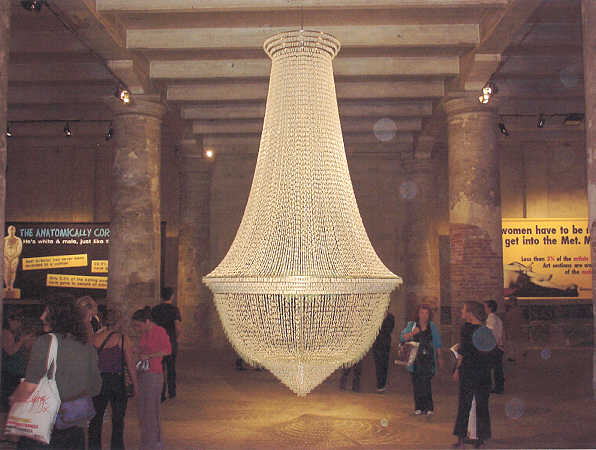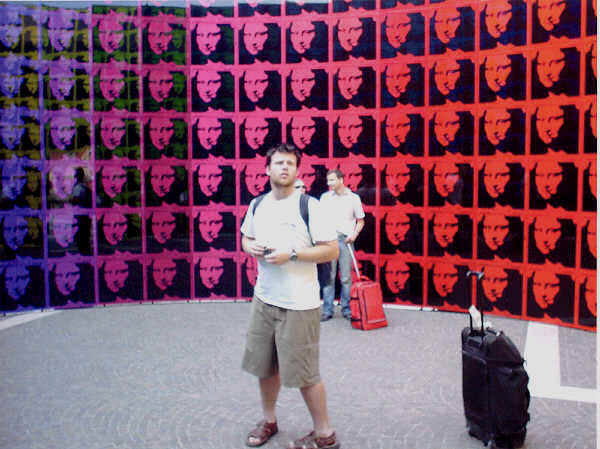| The
Experience of Art
Maria de Corral
The Exhibition that will be
held in the Italian Pavilion should not be understood as a self-
serving discussion on the art of our times, but as a field open to
distinct practices within which one can fulfill the desire to
exchange experiences, ideas, thoughts, or even to provoke them. I
would be pleased if the labyrinthian itinerary of art could be
experienced not as a finished story but as a process defined in
terms of the relationships between different subjects, forms, ideas
and spaces, that would be more "similar to a center for
experimentation than a stack of certainties" .
In that sense I would like the exhibition to deal with intensity ,
not categories. I would a1so be pleased if it were not historicalor
linear, but demonstrated the relationship that exists between
artists of different generations who debate and work on specific
ideas about art and the life of our times, creating a nexus between
approaches that are similar in intensity and obsessive quality .My
idea is for an exhibition that does not simply strive for a concept
or a gratifying visualization, but is rich in thought and pleasure.
I seek to address the themes that trouble and concern today' s
society , and that artists know how to express in such areal, poetic
and in many cases visionary , manner .
I am interested in ideas that appear as a mass of remains, fragments,
rough drafts and attempts; in works that allow the viewer to
recreate his own aesthetic experience; in artists that can
regenerate our ability to imagine different ways to inhabit the
world and to create emotions.
On the contrary , I do not seek an exhibition that, in terms of the
numbers of participants from all countries and continents, offers a
false model of universa1ity .I have decided to work with certain
authors, who have accompanied me along my lengthy artistic itinerary
, and to add many other names to this list: young people who will
accompany me through a similar experience.
Today's artists do not share a style, but an attempt to build
personal aesthetic worlds, to establish their own formal needs, to
shape a new reality for themselves, by accepting the challenge to
produce an art that makes sense in the new context that has been
delineated by the events of the past four years.
In the art of the past ten years it
is extremely difficult to detect a dominating artistic doctrine or
formal style, in blatant contrast with the constant anxiety about
the effects of globalization or multiculturalism. Artists establish
the meaning and usefulness of their own raison d'etre and the
survival of the artistic gesture in a world dominated by the media,
in which reality does not appear to manifest itself beyond
representation.
By entitling this exhibition The Experience of Art, I wanted to
share with the visitors some of the issues that artists address in
their works every day:
- nostalgia as the feeling that the past is lost forever,
expressed in a metaphorical language;
- the body and its redefinition, the introduction of
fragmentation, dissolution and even death;
- power, domination and violence in the everyday life of each
individual;
- the socio-political critique of current events by means of
irony;
- the use of images, fi1ms and narration of the past as an
immense archives thanks to which one can produce multiple operations
of redefinition and appropriation.
In approaching these issues implicit in the creative act, that do
not belong strictly to the field of art, my intention is to show
what is common in diversity , so that the viewer may admit the
quality of what is unexpected and exceptional, and abandon his own
reluctance at the idea of Pleasure in contemporary art.
Always a Little
Further
Rosa Martinez
The title of this exhibition at
the Arsenale di Venezia is taken from one of the Corto Maltese books,
a fictional character created by the Venetian writer and comic-
designer, Hugo Pratt. Corto personifies the myth of the romantic
traveller: always independent, always open to chance and risk, and
always crossing all kinds of frontiers in pursuit of his own destiny.
Taking a fictional character as inspiration is a way of affirming
that art is an imaginary construct and that fantasy helps us towards
abetter understanding of reality .In the baroque contemporary
condition, we live both a drama and a paradox: we still believe in
the need for reason, en1ightenment and utopia, even if we have
become their most ferocious critics from the new positions of post-
colonialism, race and gender. Passion and melancholy, trust and
desperation, pleasure and guilt, combine to define the critical
approach to the world in which we live.
Art is a fight in the symbo1ic order -the most relevant creators are
those who open new perspectives for linguistic, social and
ideological transformation. Today, questioning the autonomy of art
and taking aesthetics into everyday life is part of an unstoppable
widening of frontiers, of an extension of horizons that goes beyond
established models. The adventurer, the philosopher, the scientist,
the artist or the exhibition organiser, try constantly to discover
new lands and to create new possibilities of thought.
This exercise is difficult in a context where new ideas, people and
products circulate at high velocity , where the artists often mimic
each other, where institutions franchise culture and in which
marketing is the principal methodology of action. One of the main
functions of the curator is to reduce the background noise, to
assign value and to organise syntax and discourses, which introduce
sense into the unending traffic of messages.
The concept of traffic is essential to the social development, as it
imp1ies movement and interchange, not on1y in the social and
po1itical, but also in the expositive and libidinal economies.
Translation and interpretation are essential to intercultural
passages, especially to global exhibitions such as biennales.
Throughout its long history , the Venice Biennale has become the
epicentre, the privileged context for the confluence of artists
coming from different geopolitical and cultural contexts.
Offering a chance to analyse the concept of intemationality and to
redraw the contemporary topographies of alterity , the Biennale is a
unique opportunity to invent new forms of neighbourhoods between
artists, disciplines and audiences.
In this context, the exhibition Always a Little Further is an essay
presenting artists and aesthetic trends relevant at the beginning of
the third millennium. A visit to the Arsenale proposes a fragmentary
trip, a subjective and passionate dramatisation to discover the
zones of light and dark in our convulsed world. This joumey intends
to draw the most significant lines in contemporary artistic
production and to show that art stil1 holds a promise for those who
want to ernbark on the sort of voyage that made Deleuze take Proust'
s motto: the real dreamer is the one who goes out to try to verify
something.
BEIDE POSITIONEN BEWEISEN: ES GIBT
"DEN" STIL "DIE" AKTUELLE KUNSTRICHTUNG NICHT
MEHR - NUR MULTIPLE ZEICHEN DER ZEIT.
ES GEHT
UM SELBSTVERSUCHE, WIE BEIM SPACESHUTTLE VON MARIKO MORI UM
ORIENTIERUNGSVERSUCHE IN SPIEGELKABINETTEN UND DUNKLEN OFT
MYSTISCHEN RÄUMEN, UM
WIEDER ERKENNEN wie bei diesem
Leuchtobjekt? das zwar von der Ferne wie ein Kristall - Luster
aussieht aber aus Tampons für
die Regel besteht. Auch Abnutzungserscheinungen durch Überpräsenz
sind Thema |





